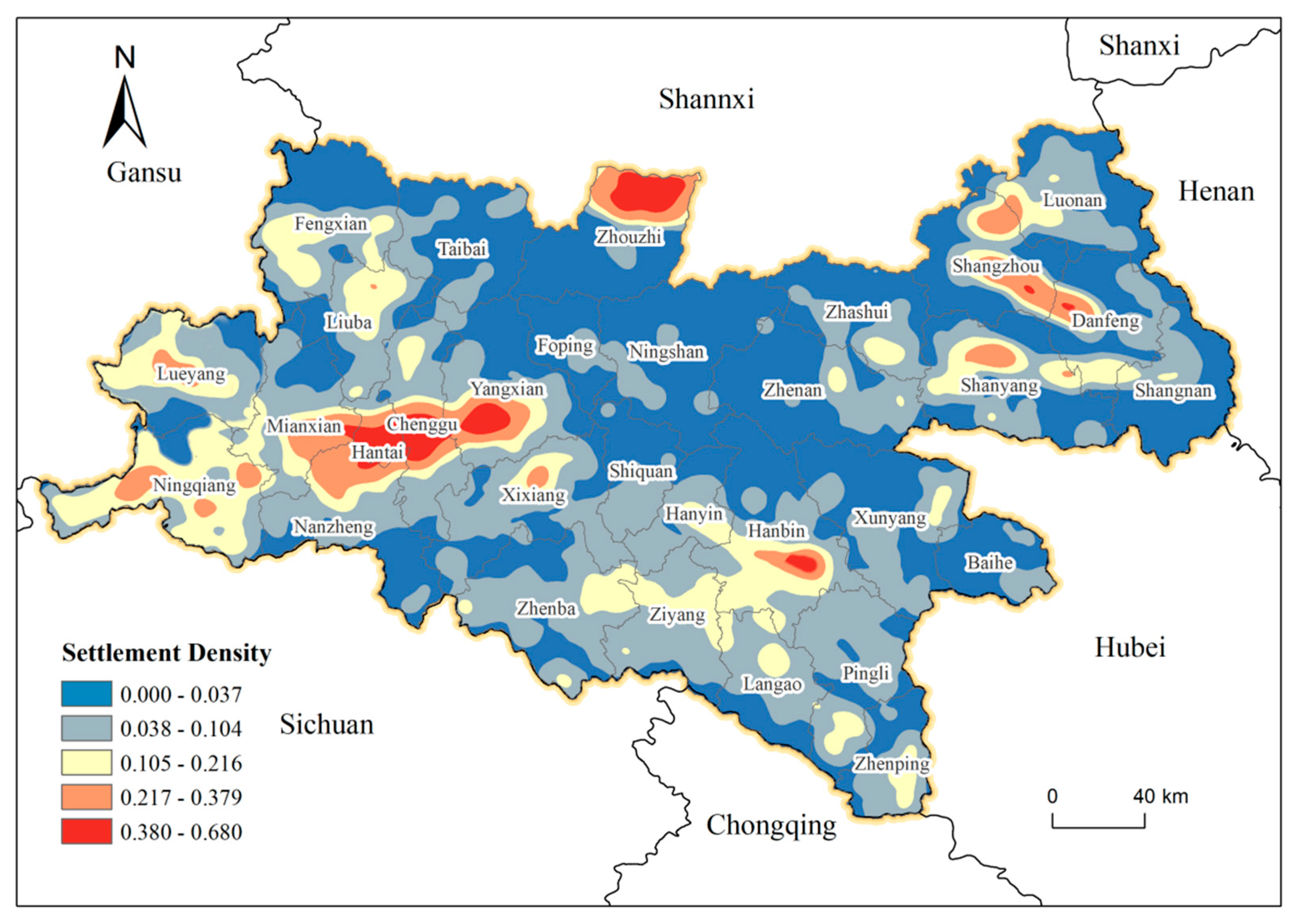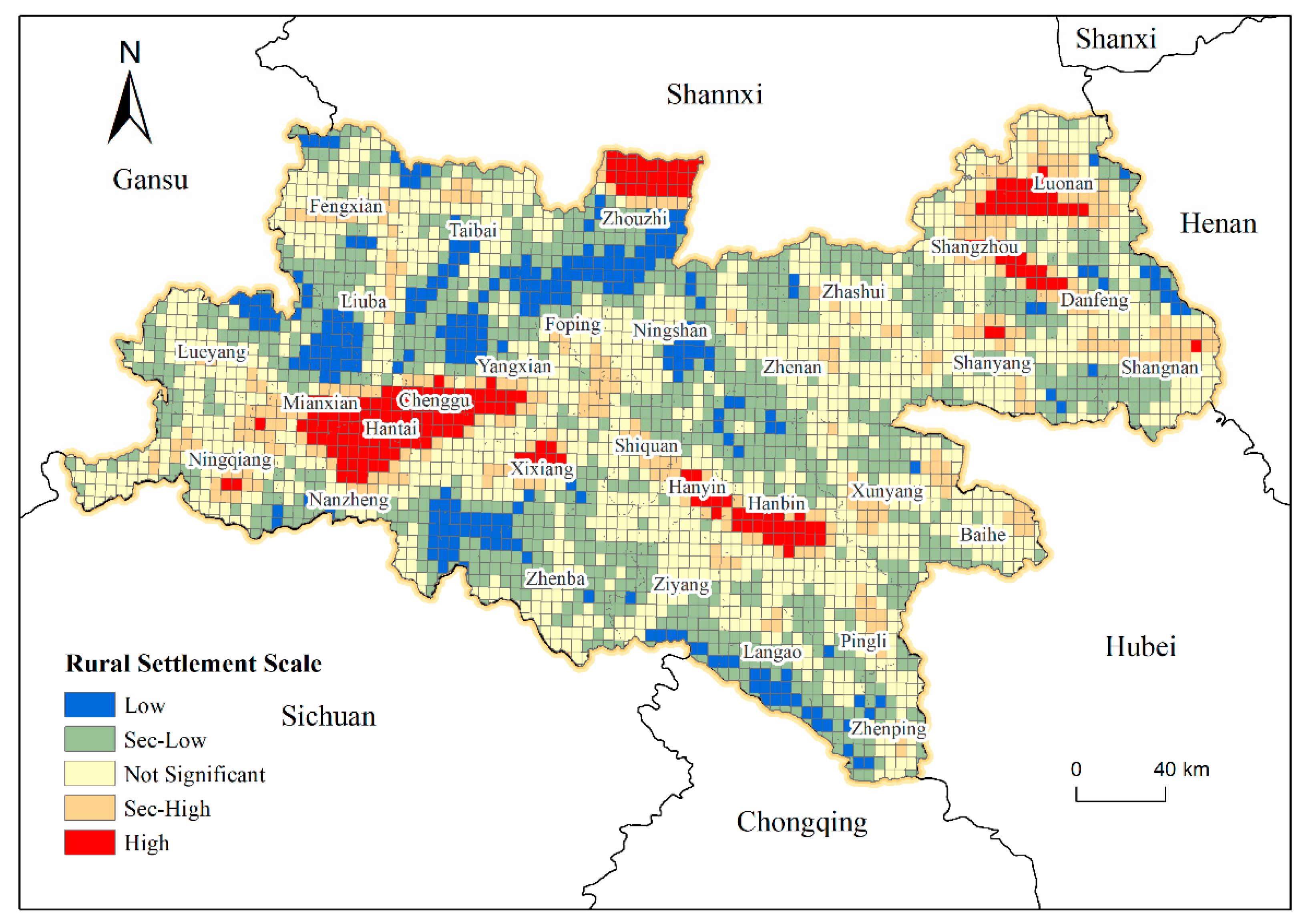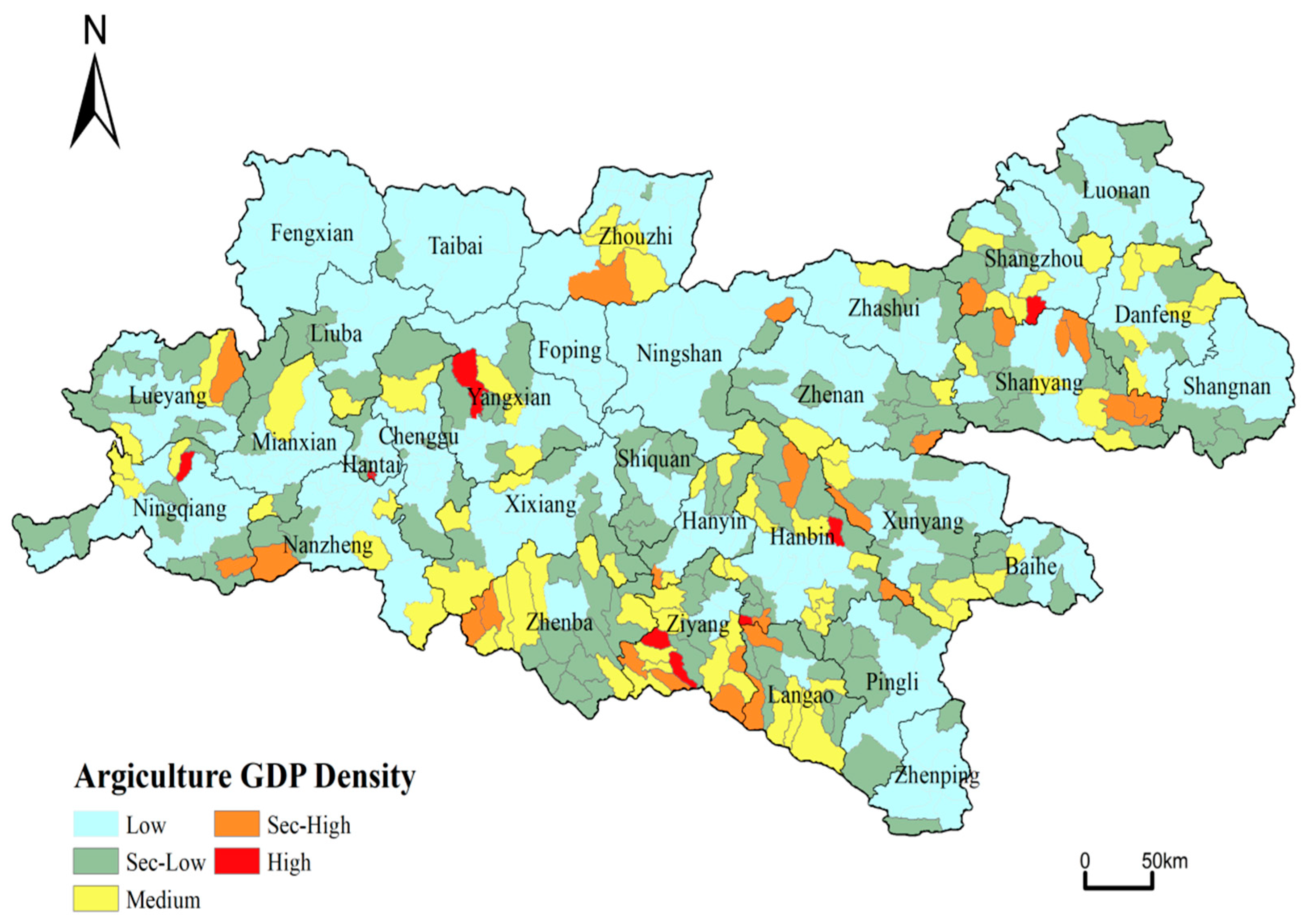Spatial Pattern and Influencing Factors of Rural Settlements in Qinba Mountains, Shaanxi Province, China
Abstract
:1. Introduction
2. Study Area
Overview of the Study Area
3. Materials and Methods
3.1. Data Source and Processing
3.1.1. Rural Settlement Data
3.1.2. Geomorphic Slope and Location Data
3.1.3. Demographic and Economic Data
3.2. Average Nearest Neighbor Index
3.3. Spatial Measurement Index
3.3.1. Spatial “Clustering” Detection
3.3.2. Spatial “Hot Spot” Analysis
3.4. Gradient Transect Analysis
3.5. Demographic-Economic Index Analysis
3.5.1. Rural Settlement Area Per Capita
3.5.2. Gross Agricultural Production Density
3.6. Impact Factor Analysis
3.6.1. Buffer Analysis
3.6.2. Geodetector Analysis
4. Results
4.1. Spatial Characteristics of Rural Settlements
4.2. Characteristics of the Scale of Rural Settlements
4.3. Shape Characteristics of Rural Settlements
4.4. Topographic and Location Factor Characteristics of Rural Settlements
4.5. Demographic and Economic Characteristics of Rural Settlements
4.6. Analysis of the Influence of Rural Settlement Factors
5. Discussion
5.1. Analysis of the Characteristics of the Spatial Pattern of the Settlements
5.2. Analysis of the Influence of the Spatial Pattern
5.3. Implications for Rural Settlements
5.4. Limitations and Future Work
6. Conclusions
Author Contributions
Funding
Informed Consent Statement
Data Availability Statement
Acknowledgments
Conflicts of Interest
References
- Azhdari, A.; Sasani, M.A.; Soltani, A. Exploring the Relationship between Spatial Driving Forces of Urban Expansion and Socioeconomic Segregation: The Case of Shiraz. Habitat Int. 2018, 81, 33–44. [Google Scholar] [CrossRef]
- Ferdous, L.; Kafy, A.-A.; Raihan Gafur, A.M.; Wakil, A.; Gafur, A.M.R.; Abdul, W. An Analysis on Influencing Factors of Rural Housing and Settlement Pattern in Rajshahi, Bangladesh. Landsc. Archit. Reg. Plan. 2017, 2, 99–109. [Google Scholar] [CrossRef]
- Li, X.; Li, H.; Zhang, Y.; Yang, L. Spatial Patterns and the Regional Differences of Rural Settlements in Jilin Province, China. Sustainability 2017, 9, 2170. [Google Scholar] [CrossRef]
- Shinde, N.N.; Gajhans, D.S. Distribution Pattern of Rural Settlement of Jalgoan District. Indian Streams Res. J. 2015, 4, 1–7. [Google Scholar]
- Nelson, P.B. Rural Restructuring in the American West: Land Use, Family and Class Discourses. J. Rural Stud. 2001, 17, 395–407. [Google Scholar] [CrossRef]
- Sevenant, M.; Antrop, M. Settlement Models, Land Use and Visibility in Rural Landscapes: Two Case Studies in Greece. Landsc. Urban Plan. 2007, 80, 362–374. [Google Scholar] [CrossRef]
- Vesterby, M.; Krupa, K.S. Rural Residential Land Use: Tracking Its Growth. Available online: https://eurekamag.com/research/003/923/003923834.php (accessed on 20 June 2022).
- Sathi Sampad, R.; Jana, N.C. Impact of Geomorphic Attributes on Rural Settlement Distribution: A Case Study of Baghmundi Block in Purulia District, West Bengal. Int. J. Innov. Res. Dev. 2015, 4, 121–132. [Google Scholar]
- Hosseini, S.B.; Faizi, M.; Norouzian-Maleki, S.; Karimi Azari, A.R. Impact Evaluation of Rural Development Plans for Renovating and Retrofitting of Rural Settlements: Case Study: Rural Districts of Tafresh in Iran. Environ. Earth Sci. 2015, 73, 3033–3042. [Google Scholar] [CrossRef]
- Walters, B.B. Explaining Rural Land Use Change and Reforestation: A Causal-Historical Approach. Land Use Policy 2017, 67, 608–624. [Google Scholar] [CrossRef]
- Wegren, S.K.; O’Brien, D.J.; Patsiorkovsky, V.V. The Economics of Rural Households in Russia: Impact of Village Location. Eurasian Geogr. Econ. 2013, 49, 200–214. [Google Scholar] [CrossRef]
- Li, Y.; Long, H.; Liu, Y. Spatio-Temporal Pattern of China’s Rural Development: A Rurality Index Perspective. J. Rural Stud. 2015, 38, 12–26. [Google Scholar] [CrossRef]
- Liu, H. Changing Regional Rural Inequality in China 1980–2002. Area 2006, 38, 377–389. [Google Scholar] [CrossRef]
- Liu, D.; Tang, W.; Liu, Y.; Zhao, X.; He, J. Optimal Rural Land Use Allocation in Central China: Linking the Effect of Spatiotemporal Patterns and Policy Interventions. Appl. Geogr. 2017, 86, 165–182. [Google Scholar] [CrossRef]
- Long, H.; Liu, Y.; Wu, X.; Dong, G. Spatio-Temporal Dynamic Patterns of Farmland and Rural Settlements in Su–Xi–Chang Region: Implications for Building a New Countryside in Coastal China. Land Use Policy 2009, 26, 322–333. [Google Scholar] [CrossRef]
- Zhou, G.; He, Y.; Tang, C.; Yu, T.; Xiao, G.; Zhong, T. Dynamic Mechanism and Present Situation of Rural Settlement Evolution in China. J. Geogr. Sci. 2013, 23, 513–524. [Google Scholar] [CrossRef]
- Zhu, F.; Zhang, F.; Li, C.; Zhu, T. Functional Transition of the Rural Settlement: Analysis of Land-Use Differentiation in a Transect of Beijing, China. Habitat Int. 2014, 41, 262–271. [Google Scholar] [CrossRef]
- Song, W.; Liu, M. Assessment of Decoupling between Rural Settlement Area and Rural Population in China. Land Use Policy 2014, 39, 331–341. [Google Scholar] [CrossRef]
- Antrop, M. Landscape Change and the Urbanization Process in Europe. Landsc. Urban Plan. 2004, 67, 9–26. [Google Scholar] [CrossRef]
- Carrión-Flores, C.; Irwin, E.G. Determinants of Residential Land-Use Conversion and Sprawl at the Rural-Urban Fringe. Am. J. Agric. Econ. 2004, 86, 889–904. [Google Scholar] [CrossRef]
- Marull, J.; Pino, J.; Tello, E.; Cordobilla, M.J. Social Metabolism, Landscape Change and Land-Use Planning in the Barcelona Metropolitan Region. Land Use Policy 2010, 27, 497–510. [Google Scholar] [CrossRef]
- Forleo, M.B.; Giaccio, V.; Giannelli, A.; Mastronardi, L.; Palmieri, N. Socio-Economic Drivers, Land Cover Changes and the Dynamics of Rural Settlements: Mt. Matese Area (Italy). Eur. Countrys. 2017, 9, 435–457. [Google Scholar] [CrossRef]
- Rosner, A.; Wesołowska, M. Deagrarianisation of the Economic Structure and the Evolution of Rural Settlement Patterns in Poland. Land 2020, 9, 523. [Google Scholar] [CrossRef]
- Grau, H.R.; Aide, M. Globalization and Land-Use Transitions in Latin America. Ecol. Soc. 2008, 13, 16. [Google Scholar] [CrossRef]
- Oldfield, P. Rural Settlement and Economic Development in Southern Italy: Troia and Its Contado, c.1020–c.1230. J. Mediev. Hist. 2005, 31, 327–345. [Google Scholar] [CrossRef]
- Milesi, C.; Elvidge, C.D.; Nemani, R.R.; Running, S.W. Assessing the Impact of Urban Land Development on Net Primary Productivity in the Southeastern United States. Remote Sens. Environ. 2003, 86, 401–410. [Google Scholar] [CrossRef]
- White, E.M.; Morzillo, A.T.; Alig, R.J. Past and Projected Rural Land Conversion in the US at State, Regional, and National Levels. Landsc. Urban Plan. 2009, 89, 37–48. [Google Scholar] [CrossRef]
- Lichter, D.T.; Johnson, K.M. Emerging Rural Settlement Patterns and the Geographic Redistribution of America’s New Immigrants. Rural Sociol. 2006, 71, 109–131. [Google Scholar] [CrossRef]
- Qu, Y.; Jiang, G.; Zhao, Q.; Ma, W.; Zhang, R.; Yang, Y. Geographic Identification, Spatial Differentiation, and Formation Mechanism of Multifunction of Rural Settlements: A Case Study of 804 Typical Villages in Shandong Province, China. J. Clean. Prod. 2017, 166, 1202–1215. [Google Scholar] [CrossRef]
- Ma, X.; Qiu, F.; Li, Q.; Shan, Y.; Cao, Y. Spatial Pattern and Regional Types of Rural Settlements in Xuzhou City, Jiangsu Province, China. Chin. Geogr. Sci. 2013, 23, 482–491. [Google Scholar] [CrossRef]
- Tang, C.; He, Y.; Zhou, G.; Zeng, S.; Xiao, L. Optimizing the Spatial Organization of Rural Settlements Based on Life Quality. J. Geogr. Sci. 2018, 28, 685–704. [Google Scholar] [CrossRef]
- Tan, S.; Zhang, M.; Wang, A.; Ni, Q. Spatio-Temporal Evolution and Driving Factors of Rural Settlements in Low Hilly Region—A Case Study of 17 Cities in Hubei Province, China. Int. J. Environ. Res. Public Health 2021, 18, 2387. [Google Scholar] [CrossRef] [PubMed]
- Li, H.; Song, W. Pattern of Spatial Evolution of Rural Settlements in the Jizhou District of China during 1962–2030. Appl. Geogr. 2020, 122, 102247. [Google Scholar] [CrossRef]
- Yang, Y.; Liu, Y.; Li, Y.; Du, G. Quantifying Spatio-Temporal Patterns of Urban Expansion in Beijing during 1985–2013 with Rural-Urban Development Transformation. Land Use Policy 2018, 74, 220–230. [Google Scholar] [CrossRef]
- Li, Y.; Jia, L.; Wu, W.; Yan, J.; Liu, Y. Urbanization for Rural Sustainability—Rethinking China’s Urbanization Strategy. J. Clean. Prod. 2018, 178, 580–586. [Google Scholar] [CrossRef]
- Shaanxi Provincial-Local Chronicles Compilation Committee Shanxi Province Publication Chronicles: Geography. Available online: http://cbkx.whu.edu.cn/jwk3/cbkx/EN/abstract/abstract1730.shtml (accessed on 20 June 2022).
- WU Chuanjun Man-Land Relationship and Economic Allocation (Collected Works of Wu Chuanjun). Available online: https://www.amazon.com/man-relations-economic-layout-Collection/dp/7507700747 (accessed on 20 June 2022).
- Hu, Q.; Wang, C. Quality Evaluation and Division of Regional Types of Rural Human Settlements in China. Habitat Int. 2020, 105, 102278. [Google Scholar] [CrossRef]
- Peeters, A.; Zude, M.; Käthner, J.; Ünlü, M.; Kanber, R.; Hetzroni, A.; Gebbers, R.; Ben-Gal, A. Getis–Ord’s Hot- and Cold-Spot Statistics as a Basis for Multivariate Spatial Clustering of Orchard Tree Data. Comput. Electron. Agric. 2015, 111, 140–150. [Google Scholar] [CrossRef]
- Song, W.; Li, H. Spatial Pattern Evolution of Rural Settlements from 1961 to 2030 in Tongzhou District, China. Land Use Policy 2020, 99, 105044. [Google Scholar] [CrossRef]
- Zhang, Y.; Wang, P.; Wang, T.; Cai, C.; Li, Z.; Teng, M. Scenarios Simulation of Spatio-Temporal Land Use Changes for Exploring Sustainable Management Strategies. Sustainability 2018, 10, 1013. [Google Scholar] [CrossRef]
- Fu, J.; Zhou, J.; Deng, Y. Heritage Values of Ancient Vernacular Residences in Traditional Villages in Western Hunan, China: Spatial Patterns and Influencing Factors. Build. Environ. 2021, 188, 107473. [Google Scholar] [CrossRef]
- Xiao, H.; Liu, Y.; Li, L.; Yu, Z.; Zhang, X. Spatial Variability of Local Rural Landscape Change under Rapid Urbanization in Eastern China. ISPRS Int. J. Geo-Inf. 2018, 7, 231. [Google Scholar] [CrossRef]
- Yang, R.; Liu, Y.; Long, H.; Qiao, L. Spatio-Temporal Characteristics of Rural Settlements and Land Use in the Bohai Rim of China. J. Geogr. Sci. 2015, 25, 559–572. [Google Scholar] [CrossRef]
- Luo, G.; Wang, B.; Luo, D.; Wei, C. Spatial Agglomeration Characteristics of Rural Settlements in Poor Mountainous Areas of Southwest China. Sustainability 2020, 12, 1818. [Google Scholar] [CrossRef]
- Popović, S.; Djurovic, N.; Murgul, V. Formation, Development and Issues of Montenegro Rural Settlements in the Case of Village Orja Luka in Bjelopavlici. Procedia Eng. 2015, 117, 832–840. [Google Scholar] [CrossRef]
- Constantin, V.; Ştefănescu, L.; Kantor, C.M. Vulnerability Assessment Methodology: A Tool for Policy Makers in Drafting a Sustainable Development Strategy of Rural Mining Settlements in the Apuseni Mountains, Romania. Environ. Sci. Policy 2015, 52, 129–139. [Google Scholar] [CrossRef]
- Chen, Z.; Liu, Y.; Feng, W.; Li, Y.; Li, L. Study on Spatial Tropism Distribution of Rural Settlements in the Loess Hilly and Gully Region Based on Natural Factors and Traffic Accessibility. J. Rural Stud. 2022, 93, 441–448. [Google Scholar] [CrossRef]
- Xu, D.; Wang, Z. Identifying Land Restoration Regions and Their Driving Mechanisms in Inner Mongolia, China from 1981 to 2010. J. Arid. Environ. 2019, 167, 79–86. [Google Scholar] [CrossRef]
- Dax, T.; Fischer, M. An Alternative Policy Approach to Rural Development in Regions Facing Population Decline. Eur. Plan. Stud. 2017, 26, 297–315. [Google Scholar] [CrossRef]
- Jones, E.E. An Analysis of Factors Influencing Sixteenth and Seventeenth Century Haudenosaunee (Iroquois) Settlement Locations. J. Anthropol. Archaeol. 2010, 29, 1–14. [Google Scholar] [CrossRef]
- Li, N.; Jiang, S. Study on Spatial Pattern of Rural Settlements in Wuling Mountainous Area Based on GIS. Wirel. Pers. Commun. 2018, 102, 2745–2757. [Google Scholar] [CrossRef]
- Ottomano Palmisano, G.; Govindan, K.; Loisi, R.V.; Dal Sasso, P.; Roma, R. Greenways for Rural Sustainable Development: An Integration between Geographic Information Systems and Group Analytic Hierarchy Process. Land Use Policy 2016, 50, 429–440. [Google Scholar] [CrossRef]
- Shcherbina, E.; Gorbenkova, E. Factors Influencing the Rural Settlement Development. IFAC-PapersOnLine 2019, 52, 231–235. [Google Scholar] [CrossRef]
- Zhao, F.; Zhang, S.; Du, Q.; Ding, J.; Luan, G.; Xie, Z. Assessment of the Sustainable Development of Rural Minority Settlements Based on Multidimensional Data and Geographical Detector Method: A Case Study in Dehong, China. Socio-Econ. Plan. Sci. 2021, 78, 101066. [Google Scholar] [CrossRef]
- Yanbo, Q.; Guanghui, J.; Wenqiu, M.; Zitong, L. How Does the Rural Settlement Transition Contribute to Shaping Sustainable Rural Development? Evidence from Shandong, China. J. Rural Stud. 2021, 82, 279–293. [Google Scholar] [CrossRef]
- Zhou, R.; Zhang, H.; Ye, X.Y.; Wang, X.J.; Su, H.L. The Delimitation of Urban Growth Boundaries Using the CLUE-S Land-Use Change Model: Study on Xinzhuang Town, Changshu City, China. Sustainability 2016, 8, 1182. [Google Scholar] [CrossRef]
- Ma, W.; Jiang, G.; Wang, D.; Li, W.; Guo, H.; Zheng, Q. Rural Settlements Transition (RST) in a Suburban Area of Metropolis: Internal Structure Perspectives. Sci. Total Environ. 2018, 615, 672–680. [Google Scholar] [CrossRef]
- Gosch, M.S.; Parente, L.L.; dos Santos, C.O.; Mesquita, V.V.; Ferreira, L.G. Landsat-Based Assessment of the Quantitative and Qualitative Dynamics of the Pasture Areas in Rural Settlements in the Cerrado Biome, Brazil. Appl. Geogr. 2021, 136, 102585. [Google Scholar] [CrossRef]
- Feng, R.; Wang, F.; Wang, K.; Xu, S. Quantifying Influences of Anthropogenic-Natural Factors on Ecological Land Evolution in Mega-Urban Agglomeration: A Case Study of Guangdong-Hong Kong-Macao Greater Bay Area. J. Clean. Prod. 2021, 283, 125304. [Google Scholar] [CrossRef]
- Li, F.; Ye, Y.; Song, B.; Wang, R. Evaluation of Urban Suitable Ecological Land Based on the Minimum Cumulative Resistance Model: A Case Study from Changzhou, China. Ecol. Model. 2015, 318, 194–203. [Google Scholar] [CrossRef]
- Yang, R.; Xu, Q.; Long, H. Spatial Distribution Characteristics and Optimized Reconstruction Analysis of China’s Rural Settlements during the Process of Rapid Urbanization. J. Rural Stud. 2016, 47, 413–424. [Google Scholar] [CrossRef]
- Gude, P.H.; Hansen, A.J.; Rasker, R.; Maxwell, B. Rates and Drivers of Rural Residential Development in the Greater Yellowstone. Landsc. Urban Plan. 2006, 77, 131–151. [Google Scholar] [CrossRef]






| Factor Type | Scope | Number of Rural Settlements (NP)/Piece | Area Ratio/% | The Density of Rural Settlements (PD)/Piece km2 | The Average Area of Rural Settlements (MPS)/km2 | Shape Index of Rural Settlements (LSI) |
|---|---|---|---|---|---|---|
| Landform | Plain basin | 1840 | 62.39 | 0.45 | 0.17 | 46.83 |
| Low hills | 956 | 17.32 | 0.05 | 0.09 | 33.39 | |
| Middle and high mountains | 1549 | 20.29 | 0.03 | 0.06 | 42.28 | |
| Slope/° | 0–5 | 2211 | 68.70 | 0.40 | 0.15 | 51.18 |
| 5–10 | 695 | 11.81 | 0.10 | 0.08 | 28.98 | |
| 10–15 | 460 | 6.01 | 0.05 | 0.06 | 22.83 | |
| 15–20 | 659 | 9.74 | 0.03 | 0.07 | 26.62 | |
| >25 | 313 | 3.73 | 0.01 | 0.06 | 18.61 | |
| Buffer distance from township center/km | 0–3 | 2037 | 56.55 | 0.17 | 0.13 | 48.81 |
| 3–6 | 1616 | 34.18 | 0.06 | 0.10 | 42.63 | |
| 6–9 | 488 | 7.21 | 0.03 | 0.07 | 22.99 | |
| 9–12 | 133 | 1.40 | 0.01 | 0.05 | 11.85 | |
| >12 | 64 | 0.67 | 0.01 | 0.05 | 8.46 | |
| Buffer distance from major rivers/km | 0–3 | 2152 | 55.47 | 0.10 | 0.13 | 50.22 |
| 3–6 | 864 | 19.77 | 0.05 | 0.11 | 30.91 | |
| 6–9 | 651 | 12.85 | 0.04 | 0.10 | 26.43 | |
| 9–12 | 462 | 8.82 | 0.05 | 0.09 | 22.34 | |
| >12 | 209 | 3.09 | 0.02 | 0.07 | 14.97 | |
| Buffer distance from main road/km | 0–3 | 2507 | 69.48 | 0.12 | 0.14 | 54.07 |
| 3–6 | 727 | 13.67 | 0.05 | 0.09 | 27.97 | |
| 6–9 | 369 | 6.57 | 0.04 | 0.09 | 19.95 | |
| 9–12 | 227 | 3.59 | 0.03 | 0.08 | 16.27 | |
| >12 | 509 | 6.69 | 0.02 | 0.06 | 24.28 |
| Factor | Landform | Slope | Distance to Main Road/km | Agricultural Registered Population | Distance from Town Center/km | Distance to Main River/km |
|---|---|---|---|---|---|---|
| Q value | 0.613 | 0.393 | 0.202 | 0.175 | 0.169 | 0.061 |
Publisher’s Note: MDPI stays neutral with regard to jurisdictional claims in published maps and institutional affiliations. |
© 2022 by the authors. Licensee MDPI, Basel, Switzerland. This article is an open access article distributed under the terms and conditions of the Creative Commons Attribution (CC BY) license (https://creativecommons.org/licenses/by/4.0/).
Share and Cite
Chen, S.; Mehmood, M.S.; Liu, S.; Gao, Y. Spatial Pattern and Influencing Factors of Rural Settlements in Qinba Mountains, Shaanxi Province, China. Sustainability 2022, 14, 10095. https://doi.org/10.3390/su141610095
Chen S, Mehmood MS, Liu S, Gao Y. Spatial Pattern and Influencing Factors of Rural Settlements in Qinba Mountains, Shaanxi Province, China. Sustainability. 2022; 14(16):10095. https://doi.org/10.3390/su141610095
Chicago/Turabian StyleChen, Sen, Muhammad Sajid Mehmood, Shuchen Liu, and Yimin Gao. 2022. "Spatial Pattern and Influencing Factors of Rural Settlements in Qinba Mountains, Shaanxi Province, China" Sustainability 14, no. 16: 10095. https://doi.org/10.3390/su141610095
APA StyleChen, S., Mehmood, M. S., Liu, S., & Gao, Y. (2022). Spatial Pattern and Influencing Factors of Rural Settlements in Qinba Mountains, Shaanxi Province, China. Sustainability, 14(16), 10095. https://doi.org/10.3390/su141610095






